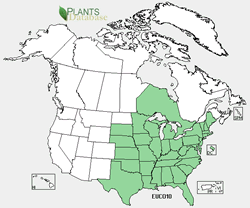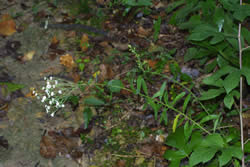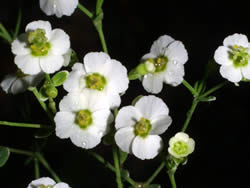USDA Forest Service Celebrating Wildflowers
|
|
|
Plant of the Week
Flowering Spurge (Euphorbia corollata L.)By David Taylor Flowering Spurge is a member of the Euphorbiaceae (Spurge) family. Like most members of the family, it has a milky sap (latex). The sap of many spurge family plants is caustic or a skin and eye irritant. The sap of flowering spurge is an irritant for many people although it has traditional medicinal uses. Many spurges use colorful bracts (modified leaves - think of the red ‘petals’ of a poinsettia) or flower appendages to attract pollinators and this species is no exception. The white ‘petals’ of the flower are actually tissue arising from a structure that holds the flowers (involucre). The flowers are very small. This spurge can grow to one meter (approximately three feet) high, but is usually around 0.6 meter (two feet) high. The stem is slender with small alternate leaves (3 to 8 cm long and 5 to 10 mm wide). The plant is dichotomously branched (repeatedly forked in two) at the top, each final branch ending in a flower cluster. Each cluster holds one pistallate (female) flower and several staminate (male) flowers. The combination of the involucre, the flowers and the appendages is called a cyathium, a term often used in technical keys. Flowering spurge is an open land species, preferring drier soils. It is commonly found in prairies and other grasslands, on rocky glades, on roadsides, old fields, and in savannas and woodlands. It occurs in open forest or forest openings. It is found from Texas north to South Dakota and east through all of the states to the Atlantic. It is also known from Ontario. Several medicinal uses by the Cherokee are reported including a treatment for cancer, a purgative, an ointment for sores, and numerous uses of the root: a physic, a treatment for pin worms, and treatment of urinary tract diseases. It can be cultivated in a prairie garden. A few nurseries sell it, but it may be necessary to grow it from seed. It has a deep taproot and should not be dug. For More Information: PLANTS Profile - (Euphorbia corollata), flowering spurge Hamel, Paul B. and Mary U. Chiltoskey. 1975. Cherokee Plants and Their Uses - A 400-Year History. Sylva, N.C. Herald Publishing Co. |
|
| NOTE: PDF format links require the Adobe Acrobat Reader to view. | |
| top | Disclaimers | FOIA | Privacy Policy | Quality of Information | Photo Credits & Use |
Location: http://www.fs.fed.us/wildflowers/plant-of-the-week/euphorbia_corollata.shtml
Last modified: Monday, 03-Nov-2008 12:23:05 EST




